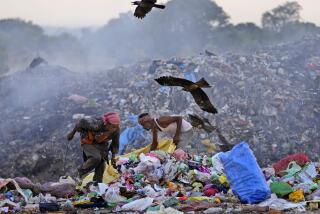Drawing a curtain on old ways
HASANPUR, INDIA — Every morning before sunrise, Ravi Shankar Singh, a cheerful man known to his neighbors as “Luv” Singh, sets out to patrol the potholed roads and rice fields of this north Indian village. He carries a whistle and a flashlight. He sings while he walks.
The village’s self-appointed sanitation guardian, Singh is on the lookout for anyone squatting in the fields or alleys, using the cover of darkness to do what millions of people have always done across India: defecate outdoors.
After years of programs to increase the number of latrines in villages, the government still has not managed to eradicate a practice that is cited in the spread of water-borne illnesses and parasites, such as diarrhea and hookworms.
Critics say the obstacle is not so much the shortage of latrines, though that, too, remains a problem for nearly half of India’s rural population. The main challenge is getting people to use the facilities they have.
Singh says he’s found a way. When he spots someone squatting, he lets loose with a blast on his whistle. Or shines his light on the offender. Or both.
No one, he says, likes being caught in the act.
“The whole idea is to put pressure on people to use the toilets,” says Singh, a 46-year-old farmer with coiffed hair, standing among a crowd of men nodding their heads in agreement. He has recruited two dozen men and women to help him scour Hasanpur for offenders. And while the squatters may not like it, Singh says, humiliation is very effective.
“In some small way, there has been a change of mind-set, a revolution of sorts,” he says.
Singh’s claim that Indians can be shamed into using latrines challenges the conventional wisdom among public health officials, who say their efforts to improve hygiene are hindered by the fact that defecating outdoors remains socially acceptable across huge swaths of Indian society.
“This is a very old practice,” says Dr. D.K. Singh, chief medical officer for the district health clinic near Hasanpur, who takes the line that it’s a difficult habit to change. “Even if they have toilets in the house, people in villages prefer to go in the fields.
“The latrine is very small,” he says, allowing a slightly embarrassed smile. “The outside is more airy.”
To “Luv” Singh, the whistle-blower, the issue of why people are defecating outdoors -- out of habit or necessity -- is secondary. He believes the power of shame can change behavior. And much rides on the consequences of his whistle. Defecation in open places contributes to disastrous levels of public health problems that belie the self-congratulatory rhetoric of India’s economic boom.
A 2003 government report said that only 30% of India’s wastewater was being treated, with the rest flowing into rivers and seeping into groundwater. And a 2002 report by the World Health Organization said about 700,000 Indians die each year of diarrhea, the majority of them younger than 5.
But the perils of defecating outdoors go beyond poor sanitation.
“In many places, the problem is not one of disease, it’s that women are being raped when they go into the fields at night, or young girls are being kidnapped by bandits,” says A.K. Singh, director of a UNICEF water sanitation program near Varanasi in northern India.
The Indian government has been trying since the mid-1980s to increase the number of latrines for villagers.
Its Total Sanitation Campaign aims to end outdoors defecation across India by 2012, and the government says it is encouraged by surveys showing that the number of latrines, and their use, is rising. It says it has doubled sanitation coverage to almost half of rural India, and aims to activate its campaign to install sanitary facilities at homes in all of India’s nearly 600 districts by year’s end.
But critics say even that progress leaves tens of millions of people answering nature’s call in fields, along railroad tracks and on sidewalks, even in large cities such as New Delhi. They say government programs have focused too heavily on statistical targets for installing latrines and not enough on the need to change attitudes toward using them.
The government acknowledges that its initial campaign offering subsidies to encourage people to install latrines was a failure, as chronic corruption diverted money from its intended use. And it was hampered by the indifference of people who were never clear on why they should break with age-old habits, leaving many government-provided latrines half-installed or unused.
The government’s current program asks people to pay at least half the cost of the latrines, on the premise that the investment will instill a corresponding commitment to use them.
Some health professionals see indications of change.
“Clearly there has been cultural resistance to changing behavior, but it’s also apparent that people feel some shame about going in public,” says A.K. Singh.
“We see signs, for example, of upper-class people now pressuring poor neighbors not to defecate in their fields. It is no longer always a socially acceptable act.”
Experts say widespread change won’t occur until people understand the connection to public health.
During the monsoon season, when water levels rise, Dr. Singh and his colleagues at the clinic see more than 200 patients a day who suffer from skin boils, intestinal ailments and other maladies attributable to ingesting contaminated water. Almost all have no idea why they are sick.
The doctor says he doesn’t expect to see significant change until rural India’s notoriously low literacy levels improve.
“They are uneducated and illiterate,” Singh says. “When we get a chance, we try to explain the connection between going in the fields and their health. But look at how busy we are. We don’t have the time to go into detail with every person.”
Yet not everyone sees illiteracy as the root of the problem.
“Even literate people in villages squat outdoors,” says Sudhirendar Sharma, a water expert and development analyst with the Ecological Foundation, a nongovernmental agency in New Delhi. “People who have spent all their lives in villages tend to live in a culture in which it is not a taboo to defecate in the open.”
Sharma says the use of public humiliation with whistles and lights is an intriguing tactic. But he worries, too, about the ethics of self-appointed scolds policing people’s intimate habits.
“Humiliation may work, but people do this in the dark or in hiding because it is a private act, not necessarily because they are ashamed,” Sharma says. “There are bound to be people who say, ‘Who gives you the right to encroach on my privacy?’ ”
But “Luv” Singh says defecation in open places is a community issue, and sanitation a matter of pride for the village.
He beams when he describes his work, and eagerly leads a visitor down one-lane roads that cut across Hasanpur’s rich green fields to show off new toilets and a freshwater pump at the school. Singh says he, too, grew up relieving himself in the rice paddies. Now, he says, village children find it just as natural to use the toilet.
“If we can stop it, our life span will go up,” he says.
What about public urination, he is asked? What are the prospects of stopping that ubiquitous, unsanitary habit?
The men surrounding Singh break into laughter.
“That, I can’t stop,” he says.
--
More to Read
Sign up for Essential California
The most important California stories and recommendations in your inbox every morning.
You may occasionally receive promotional content from the Los Angeles Times.










